HP Veer 4G Review - Getting Us Excited for Pre 3
by Brian Klug on June 7, 2011 5:01 PM EST- Posted in
- Smartphones
- HP
- AT&T
- Palm
- veer
- webOS
- HSPA+
- Mobile
- HP Veer 4G
I suppose now is as good a time as any to go into the cellular connectivity situation on the Veer. There was some confusion initially about whether the Veer “4G” truly had HSPA+ or not, and a number of incorrect assertions came up surrounding whether HSDPA 21.1 (and thus 64QAM) support is required for a device to be considered actually HSPA+. I went into this in my earlier this just in post when talking about the Veer 4G and encourage you to read it, but wanted to go in a bit more depth with explanations now.
Before I go any further, let’s discuss modulation. Modulation is the act of physically encoding data on a signal, or in this case an electromagnetic wave. The simplest example of modulation is On Off Keying (OOK) or Amplitude Shift Keying (ASK). With OOK, you can imagine no light at all being coded to a binary 0, and the presence of light being coded to a binary 1. Then, with the simple act of blocking the light (either with a chopper, or your hand, or by turning the source on or off) you can encode that binary 0 or 1. It turns out that just turning a source on and off (and only using two states) isn’t a very spectrally efficient means of encoding data. But there are other ways of encoding data. Regardless, amplitude is one parameter we can vary.
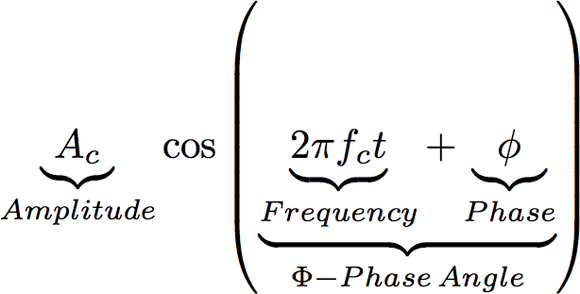
The next is the frequency of the electromagnetic wave. To explain this we need to first realize that a wave can be described with a cosine. Looking at the equation shows us almost everything we can modify or modulate with respect to the signal, with the exception of one more parameter - polarization. Those three are amplitude, frequency, and phase. Everything inside the cosine’s parameter together serves to describe the wave’s phase angle. Obviously the next possible thing to modulate is this phase angle – we could code a phase of 0 to a binary 0, and phase of π (180 degrees) to a binary 1. This is called Binary Phase Shift Keying (BPSK). You can imagine using more positions along the phase to encode more data – just go up a power of 2 and encode a phase of 0 to binary 00, phase of π/2 to 01, π to 11, and 3/2π to 10. Often this is shifted by π/4, but in either configuration with 4 points you get to Quadrature Phase Shift Keying (QPSK).
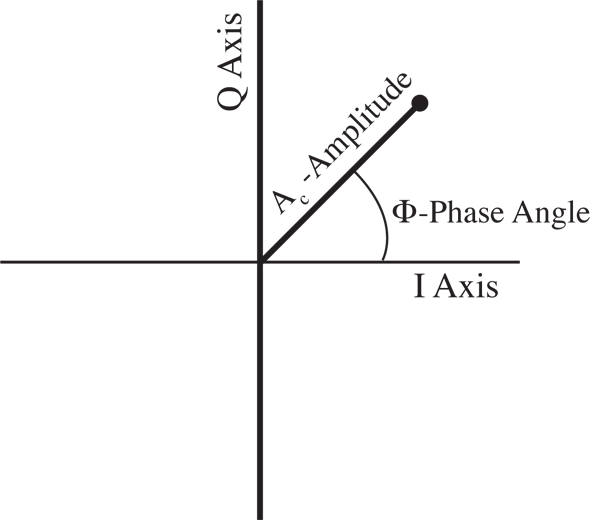
This can be visualized in polar coordinates, where the amplitude is the distance from the origin to a point, and the phase angle is simply the angle from the x-axis to the point. Now the term phase angle makes sense. A plot very similar to this is called an I/Q plot, with I standing for in-phase, and Q for quadrature (90-degrees out of phase). This is essentially a polar plot, but with the names for the two orthogonal components just labeled I and Q due to their common use in an IQ modulator.
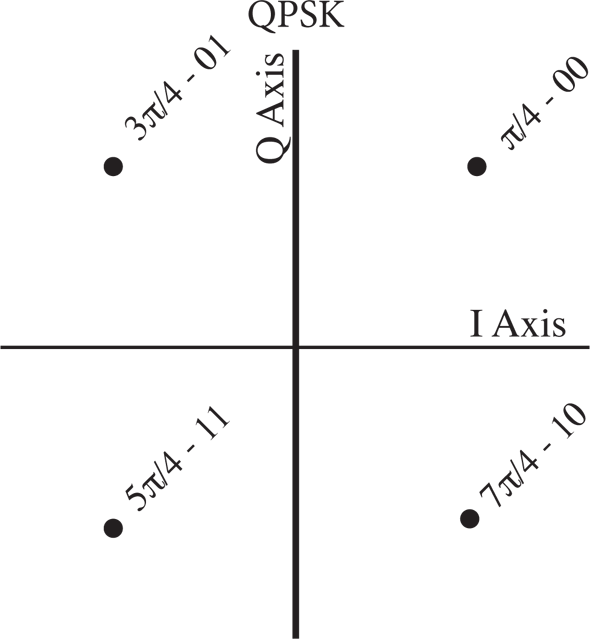
It doesn’t take much imagination to see how you can modulate amplitude alongside phase and get even more points to encode to binary data. This is called Quadrature Amplitude Modulation (QAM) and essentially is the combination of both ASK and PSK. If you divide the I/Q plot into regions, each can then correspond to some predefined coding. The encoder and decoder share this mapping, and we can transact data based on a specific value of the amplitude and phase angle.
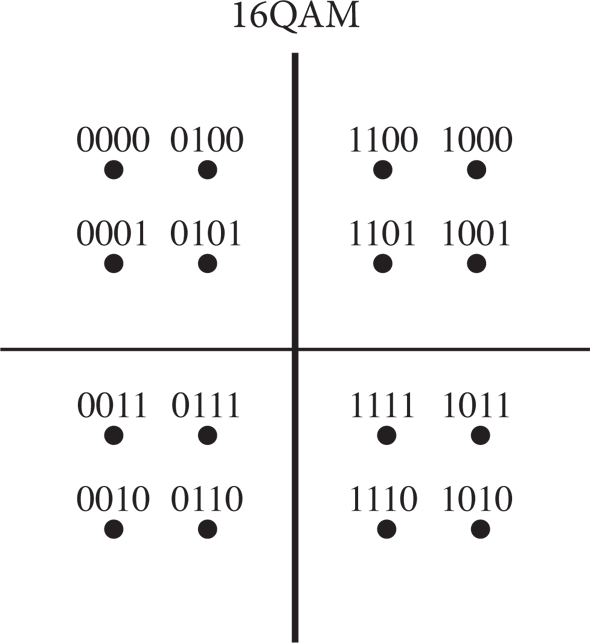
Things go by powers of two here so we can add one more digit of coding – thus 16QAM lets us code four binary digits, and 64QAM lets us code six. These different codings are simply different higher powers of QAM, and sometimes you’ll just hear them referred to as higher order modulation schemes. All we’re doing is increasing the power of two and dividing the IQ plot into more points. Plotted on the I/Q plot, these points form what’s called a constellation map.
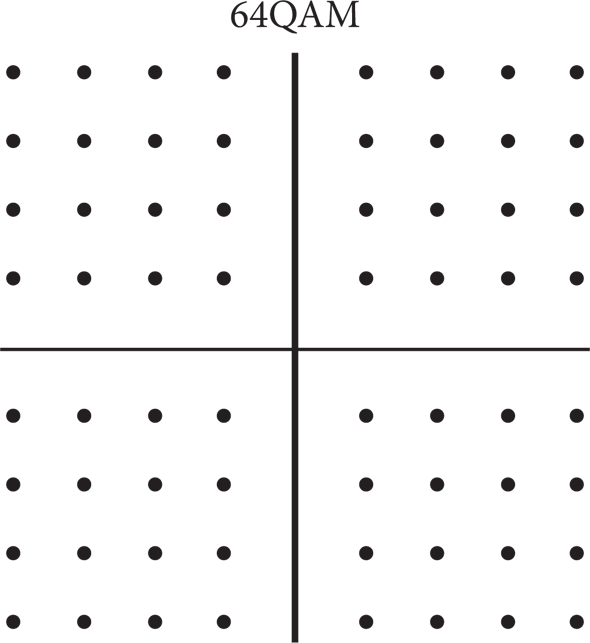
I'm not even going to bother labeling the codings on this one...
There is a tradeoff, however. Moving to more and more decision points results in a densely packed constellation, with correspondingly less space between each point. We can’t get any more area, since we’re encoding between an amplitude of 0 and 1, and phase angle of 0 and 2π. As a result, sensitivity to noise and interference goes up, as tolerances (the area between points) shrinks. On the demodulator, there’s a component called the decision circuit whose job it is to decide what coding each point should correspond to. It does its job simply by looking at where points land and how close they are to a symbol. There are ways of improving the decision circuit, but there’s no getting around the fact that each power of two makes the decision circuit’s job harder.










25 Comments
View All Comments
peskypescado - Tuesday, June 7, 2011 - link
I have been a webOS user for a couple of years now and I can tell you that the Touchstone definitely charges _significantly_ faster than the same AC charger just plugged into the phone via microUSB. I'm not sure exactly why, but it is consistently faster on both of the Pre's we have at my house. For me, it is a bigger benefit for why I use a touchstone than the convenience of just being able to set my phone down.Brian Klug - Tuesday, June 7, 2011 - link
Interesting - I mean that definitely bears itself out in the results. I originally ascribed the differences to just charging management, but there definitely seems to be something said for the touchstone charging faster. I'll see if I can find more.-Brian
Johnmcl7 - Tuesday, June 7, 2011 - link
I'm guessing as SE devices rarely seem to get mentioned here that they're just not available in the US? Their X10 Mini Pro is a very similar design and size to the Veer although I think SE's design is better in a few ways, they've gone for a horizontal slider (or whichever way round it is when you turn the phone 90 degrees to use the keyboard) which gives more room and makes for a better keyboard. The keys are well spaced and have a solid 'click' when pressed so that despite its size it works well, better in fact than some of the bigger qwerty devices I've used. The X10 Mini Pro has a 3.5mm port onboard and a micro USB port (for data and charging) plus the back is removable to get access to the user-replaceable battery and has expandable storage through microSD.Unfortunately it's also an ARM11 SoC although it's driving a small screen compared to other smartphones, SE's customisation on top of Android is a bit messy in places as well although in general performance isn't bad. The phone seems to have had reasonable appeal, it's particularly popular amongst my female friends looking for a small phone to slip in a handbag/pocket.
John
Penti - Wednesday, June 8, 2011 - link
Yes they have, but the SE X10 Mini Pro isn't a fluid phone in regards to performance and it's not that hard to use the gd 3.5 mm adapter you snap on, or a USB-charger & data cable both included in the box. It's not that you can't use those.However the X10 Mini Pro is or was available directly from SE, or from Verizon and AT&T. So on. But the new Xperia Mini Pro should come any day. And it's hardly the only cell phone with a slide out keyboard.
As a Swede I would just say stay away from SE basically. They are not up to the task and un-updated software is just a pain. I wouldn't want to use timescape either. It's basically in regard to the X10 mini a phone even too weak for Angry birds.
The guys working in Lund for SE would probably do a lot better job at one of the Chinese manufacturers any way. Nobody in China will miss their factories either. It's virtually a collapse business and has been for years any way. Seriously they are not competitive, and in the states you got stuff like Motorola Milestone/Droid and Droid 2, and so on that's popular instead I guess. The SE's might fit the people who only text and so on. But that misses the point, and it's overpriced and old legacy stuff by now.
Johnmcl7 - Thursday, June 9, 2011 - link
Of course it's not the only phone with a slide out keyboard but it's one of the few that's so small. As a non-Swede I think the advice to stay away from SE odd, there's not many phones like the X10 Mini Pro and it has the Veer beat in just about every way going despite the SE being a much older phone. I haven't seen these 'fluid' problems you mention and the phone is popular amongst my female friends.John
Penti - Friday, June 10, 2011 - link
It's an abandoned phone by now any how. If the Xperia Mini Pro will be any good I don't really know, but it can't be worse and is out any day.As I Swede I'm proud of Ericsson and so on in the telecom industry, they are good and successful, still have manufacturing in Sweden for that matter, but simply not SE. SE is one of the failed mobile brands to begin with, they sell roughly half as many phones as 2007, they are among the ones that have gone bad together with Motorola which collapsed al together but with products looking strong even though they are at about 20% of their 2007 volume and less then that of their 2006 volume (which are just begin to sell again in Sweden mind you at least they are looking up), LG that has stopped growing, SE isn't that respected. Something like Motoblur I would probably prefer over Timescape as it's less intrusive. SE has really screwed up with their software and launcher. I'm fine with running the stock UI and launcher, but you don't really have that choice from mentioned brands.
But hey, at least the new Mini Pro doesn't look like it's from <2009.
It's however a common problem with games and other software lagging on the X10 Mini Pro. The UI has pretty much constantly had performance problems. I.e. not being fluid. (Doesn't mean all users experienced it or that they experienced it over all time they had the phone.) They have messed it up so many times on the firmware side. It's simply not recommended for smart phone usage here.
However a slim company like SE with no software expertise or manufacturing expertise and not much to speak of wouldn't be a loss if they disappeared. They are just building phones with Qualcomm chipsets and not contributing much, they need to pick up if they want to continue delivering phones. They might manage to do it with their revised software on Gingerbread+ but that remains to be seen.
A X10 Mini Pro is however about the same size like something like this HP Veer though, or other non-keyboard smartphones for that matter (X10 Mini non-pro is the one that sold here in Sweden and that Three etc peddled.). I simply wouldn't recommend the X10 Mini to anybody for that matter. 320x240 is simply not suitable for smart phones. The new model will also be a 3" phone although about the same physical size so it's not really that significantly smaller then any other phone. Smaller then the Desire Z and equivalents yes. Old device is simply not in the same league as this HP Veer or most smart phones, small or large. New Xperia Mini Pro however looks much improved. Not saying HP Veer is a feature phone replacement for the same crowed however. SE's device is clearly trying to grow up though. But at 320x480 is still aimed at low-end users.
Not that I like using Android in landscape mode however. I think a vertical slider is much better in most cases, however on phones like N900, E7 (Nokia) I would prefer the landscape mode and keyboards. However if you like an Android with horizontal keyboard there is lot of others to choice from other then SE, I did think about buying one even though the X10 Mini wasn't in question then do to it's software troubles. Anywhere from Motorola, Samsung, LG or a few other devices in the unites states, where you often have branded devices like T-mobiles (HTC) G1 and G2 and MyTouch series. I don't see SE filling a space there really even though it's sold by the operators and stores there. While here in Europe we haven't seen as many choices.
jnmfox - Tuesday, June 7, 2011 - link
"...still thicker..., which is perhaps an even more important criteria for female shoppers.""Whether the Veer goes in the front pocket or is small enough to make it into the back pocket is ultimately a matter of clothing choice and personal preference."
"I will say that it’s refreshing to carry something around that doesn’t weigh my pants down"
robinthakur - Wednesday, June 8, 2011 - link
It's all rather sexist tbh. Lots of men don't want a massive brick of a phone and value a slimline handset that can fit in skinny jeans or tailored jackets without ruining the lines. It's not just a girl thing. This often seems to come up on tech sites, and seems to assume and imply that all men wear baggy jeans and dress like hobos...HowQuaint - Tuesday, June 7, 2011 - link
I'm coming up on 2 years with an original Pre and it's getting long in the tooth. Seems to "forget" to send me calendar notifications and lock up all the time, plus I've already had to replace the battery. I've been thinking about tossing it out a window and getting a nice Android device or maybe even a dumbphone, but HP might woo me back if Pre 3 (or even Veer) won't have these reliability issues. It's somewhat disheartening to see they still haven't learned their lesson with not having enough options, for example I get poor cell coverage at work so turning off 3G might keep the phone from draining its battery on a daily basis. The funny thing is that despite all the hate for the original hardware, mine has actually been pretty robust -- I'm more of a fan of the hardware than of WebOS and never experienced the wobbly keyboard issues.Lt.PorkyPine - Tuesday, June 7, 2011 - link
I also have made my original pre for 2 years. I love the OS and have had only minor hardware troubles. Had to have my pre replaced one. I hope to get the pre 3 so long as it comes to sprint. I'm very excited about the new hardware and 2.0.Hopefully HP can start to bring regular hardware updates to the webOS platform. It will also help if the comments from HP about licensing webOS to 3rd party hardware makers like HTC and Samsung are true.